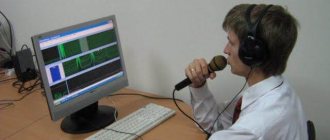What is stuttering?
First, let's figure out what it is and what provokes the development of stuttering. It is now a very popular opinion that stuttering is a genetically determined disorder. There is plenty of evidence for this; many scientists confirm this theory in the course of their research in this area. Other reasons (stress, poor socialization, etc.) can become a trigger factor only if there is a predisposition.
We all experience stress, various nervous shocks, suffer from many diseases, but at the same time we may not suffer from stuttering. This disorder develops on “fertile soil” caused by genetic disorders.
Stuttering is a typical neurological disorder that is psychogenic in nature. Accordingly, treatment of stuttering, both in adults and in children, should be aimed not only at correcting the functioning of the nervous system, but also at higher nervous functions - at the psyche.
In the treatment of stuttering, it is customary to distinguish three directions: suggestion, relaxation and distraction. It makes no sense to describe these areas separately; they are all effective only in conjunction with each other. It is more expedient to divide the methods of treating stuttering in adults into medicinal and non-medicinal: such a division better reflects the essence and goals of the treatment process.
Clinical picture
The main symptom of logoneurosis, which is included in the clinical picture, is stuttering. This concept can also include:
- repeated repetition of individual words or syllables that a person is not able to control;
- stretching or lengthening a word;
- increased tone of the facial muscles;
- respiratory spasms;
- high activity of facial expressions.
One of the obvious signs of speech logoneurosis is the presence of spastic breathing. Breathing is directly related to the voice, articulation, and movement of the larynx. Impaired respiratory activity leads to intermittent speech. If attempts are made to cope with this, the hitches only become more obvious and pronounced. Logoneurosis according to ICD 10 has code F-98.5. This is a group of disorders that begin in childhood.
Symptoms and types
There is a classification of logoneuroses. As it progresses it can be:
- Permanent. It appears constantly and in all forms of speech.
- Recurrent. appears and disappears without reference to various factors. Normal speech can be maintained for a long period.
- Wavy. The speech disorder subsides and then recurs.
According to the type of seizures, logoneurosis is divided into:
- Tonic type. Muscle contractions occur over a long period of time and have great force.
- Clonic. Alternating short spasms.
- Mixed. Both types are observed.
According to its clinical form, logoneurosis in children is classified into neurotic and neurosis-like. The neurotic type occurs in the absence of intrauterine or birth injuries and pathologies. The cause of this form is often psychological trauma or the introduction of a second language in early childhood. This type of logoneurosis is functional in nature, in which the brain structure is not damaged. That is why it is easier to treat.
Neurosis-like stuttering is often diagnosed in women during pregnancy, which is accompanied by toxicosis and injuries. In this case, speech disorders occur due to damage to the brain, its speech center. Clear manifestations are noticeable at the age of 3-4 years, when the child begins to actively talk, construct complex sentences, and communicate with others in separate structured phrases.
Degrees of the disease
There are three degrees of severity of logoneurosis:
- mild form - isolated convulsions are observed in spontaneous speech;
- medium – convulsions appear when speaking, but the person can speak absolutely normally for a long time;
- severe - speech convulsions are observed in any situation, including if a person is talking to himself.
This division is of a formal nature. Most experts note this classification as untenable, since it depends on many factors - time, specific situation, place.
Non-drug treatment for stuttering
The first thing a doctor who wants to cure a patient with a stutter must do is convince him that he must speak. You need to talk as much as possible, without being embarrassed by the speech impediment (this will only make things worse). Stuttering is not one of those diseases that needs to be hidden from society - there is nothing wrong with that.
You need to understand one simple pattern: the more you speak, the better your speech becomes. Stopping the conversation, on the contrary, aggravates the disorder. A good option is to find a job that involves communication. Yes, it will be very difficult at first, but the result (believe me!) is worth it. Remember that stuttering is a behavioral disorder that you can correct even on your own. Don't be afraid to speak up!
You may be offered behavioral psychotherapy or hypnosis treatment for stuttering. If you can't cope on your own, this should help you. However, it is worth saying that the effectiveness of psychotherapy for stuttering is very doubtful: the results of such treatment are not comparable with the results of “self-therapy.”
For the most part, your chances of quickly getting rid of your stuttering are up to you. The doctor will tell you what to do, having become closely acquainted with your problem (methods and approaches are individual for each person), and will monitor your progress, but the most important part of the treatment still falls on you.
Stuttering in children
It is necessary to correct stuttering with frequent sessions with a specialized specialist - a speech therapist. The work is aimed at:
- freeing the baby’s speech from excessive tension;
- elimination of incorrect pronunciation;
- formation of clear articulation, correct and expressive speech.
Speech therapy work is the basic method of therapy around which other methods of correction are built. First, classes are conducted in private with a speech therapist, who teaches the child various techniques for correct pronunciation of individual words, phrases and sounds. Then the exercises go on their own. All acquired skills are reinforced in everyday life, i.e. in communication with parents and peers.
There are several important rules for children who stutter when conducting classes:
- Planning your statement. At the very beginning of work, it is better to avoid improvisations in speech, so as not to provoke speech spasms. When a child knows what he wants to say, he becomes more relaxed and emotional tension goes away.
- Breath. Each pronunciation of a word should occur while exhaling.
- Pauses in speech. A short stop allows you to gain some air while the stutterer can think about what he wants to say next. Pauses can also be used within long sentences.
The correction is carried out by a specialist with sufficient experience. The speech therapist must take into account the individual characteristics of the child, including his age. For preschoolers, exercises should be formulated in a playful way so that they are interesting to children - this way the specialist’s contact with the child is better formed. It is important to clearly plan your classes, trying not to make them long - 20 minutes is enough.
Drug treatment is prescribed by a neurologist if the baby has neurological problems. Among the drugs most often prescribed are muscle relaxants (to relieve muscle spasms) and nootropics that improve cerebral circulation.
It is important to give the child stability so that he feels calm in his environment. You need to play with your baby more often, show him his importance in every possible way, and protect him from all kinds of stress. Only a calm atmosphere will help him cope with this problem.
If you are wondering how to counsel children with stuttering and how to determine the clinical form of stuttering, the severity of stuttering, the location and form of seizures. If you also want to avoid mistakes when correcting stuttering, we are waiting for you at the practical intensive “Stuttering: symptoms, modern methods of correction”!
You will learn:
1. differentiate between iterations and true stuttering;
2. apply massage techniques for stuttering by L.N. Meshcherskaya. and Arkhipova E.F.
3. write a psychological and pedagogical conclusion correctly;
4. recommend the use of a reminder and rules of speech for stuttering and hydrotherapy sessions at home.
Would you like more information about the intensive? Click here!
Prevention of logoneuroses
Prevention is measures that can prevent the appearance and development of speech in a child and an adult. Such measures can reduce the risk. There are three types of prevention of logoneurosis:
- prevention of speech disorders in children;
- relapse prevention;
- prevention of problems with the child’s social adaptation.
If the baby is too sensitive, weak, or has an unstable psyche, such measures are especially useful. When the first symptoms appear, the parent should immediately contact speech therapists and neurologists.
What to do if a child stutters?
Stuttering is a fairly common problem in children. But this is a fixable situation if you approach it correctly and start working on time. How to do this, Anna Ershova, a specialist in the rehabilitation work of the capital’s family, tells us.
Stuttering is a violation of the fluency of speech, which can manifest itself in hesitations, repetition, and stretching of syllables and sounds. It is accompanied by muscle tension (cramp) of the organs of articulation, breathing, and voice. “ Stuttering most often occurs between the ages of two and five years, when phrase speech is rapidly developing. By the way, it should be noted that approximately 5% of children suffer from stuttering. And in boys this diagnosis is noted 3-4 times more often than in girls
”, notes Anna Ershova.
Stuttering can occur acutely, that is, suddenly, due to mental trauma - fear, conflict, unexpected change in lifestyle (for example, a child began attending kindergarten, a youngest child was born in the family) or it can increase gradually.
The likelihood of stuttering increases if one of your close relatives suffers from the disease, with frequent respiratory diseases, even with impaired attention. After all, attention and speech are closely related: if a child is easily distracted, mentally jumps from one to another, then the verbal formulation of thoughts loses rhythm.
“In case of acute stuttering, the first step is to eliminate the situation that is traumatic to the child’s psyche. Avoid anything that overstimulates or upsets your child. Cancel attending entertainment events, watching TV programs, and receiving guests. Pay attention to healthy sleep, maintain silence. Try to speak more slowly yourself. Walk more in the fresh air, draw, sculpt. Strengthen your nervous system through playing with sand and water; it is also useful to sing a lot and move to calm music.”
, notes the specialist.
The speech status of children who stutter may change. At times the child speaks well, and suddenly there is a deterioration. Typically, parents attribute this to the time of year (in spring and autumn, stuttering intensifies) or the time of day (some children, when waking up, are capricious and stutter more; others stutter more in the evening, tired of the day's activities). There are children whose deterioration occurs after an illness. We can say that wave-like behavior is characteristic of the course of stuttering.
“You should definitely visit a neurologist, speech therapist, or psychologist. A neurologist will be able to determine the reasons that led to impaired speech function. To do this, the specialist will need to conduct a series of studies of the brain and central nervous system, then prescribe medication. A speech therapist will help you breathe correctly when speaking, teach you how to pause during dialogue, and play sounds. A psychologist will teach a person who stutters to communicate in different life situations, help him express himself emotionally and creatively
—
in music, painting, acting on stage
,” says the specialist.
Press service of the Department of Labor and Social Protection of the Population of Moscow
Types of stuttering
There are several types of stuttering:
Depending on the mechanism of occurrence, pathology can be respiratory, vocal and articulatory-phonetic.
- With the respiratory or breathing type of speech delay, the pathology is associated with a lack of air. Because of this, the baby cannot finish a phrase or word while exhaling. During a conversation, his face becomes tense or distorted;
- Vocal stuttering is caused by involuntary closure of the vocal cords. Occurs most often with vowel sounds;
- The articulatory-phonetic form is characterized by spasm of the facial muscles. Outwardly, this is expressed by opening the mouth and contracting the lips.
Due to their occurrence, there are 2 forms:
- neurotic stuttering (logoneurosis) - associated with acute or chronic stress in children 2–6 years old, with no organic damage to the nervous system;
- a neurosis-like form occurs in children aged 2–3 years as a result of damage to the speech center of the brain due to injury or illness.
As you can see, stuttering most often begins in preschoolers. This is the most vulnerable age.
According to clinical manifestations there are:
- tonic form - hesitation, prolongation of sounds, pauses;
- clonic form - repetition;
- mixed form.
Basic methods of stuttering prevention
Primary prevention of stuttering is aimed at eliminating risk factors. Includes giving up bad habits during pregnancy and regular monitoring by a doctor, as well as following recommendations on lifestyle and treatment of concomitant diseases. It is important to prevent birth injuries and any injuries in subsequent years of the child’s life.
Secondary prevention of stuttering is working with children at risk. They do not yet have the disease, but they have a predisposition. They should be observed by a neurologist if there are any problems, as well as by a speech therapist, psychologist, and receive appropriate treatment.
Family plays a big role:
- It is necessary to create a favorable atmosphere at home, avoid conflicts and quarrels, and treat the child kindly. Try to communicate more and pay attention more often to his needs and desires. When you speak, do not distort words or lisp, but pronounce them clearly, moderately loudly and slowly, but expressively;
- If you have a close relative with a stutter or other speech impairment, you need to minimize his communication with the baby. Give up the idea of raising a child prodigy, do not make demands on him that are beyond his age. When choosing entertainment, activities, games, even educational ones, pay attention to his mood, character traits and nervous system: what suits one child may not suit another;
- If children of preschool age have any speech impairment, then they should study in a speech therapy group, or the parents themselves should find a teacher and provide regular classes. It is necessary to eliminate all speech disorders before school so that they do not progress and do not give impetus to the development of stuttering. This will interfere with the assimilation of the school curriculum. Also, the student will begin to avoid peers, in adolescence he will develop complexes, fear of speaking in public, fear of communication;
- Develop a daily routine and rest schedule, and strictly adhere to it with the whole family. Avoid emotional and physical overload. Horror films with a crime plot are contraindicated for all children, and even more so for those at risk;
- When two languages are used in a family, it is better to teach the child one language. By about 4 years old, he will master it, after which preschool children will be able to learn a second language, and he will not have problems with speech.
In addition to primary and secondary prevention of stuttering, there is also tertiary prevention. Its goal is to prevent the progression of the disease and the development of complications. It consists of timely treatment, rehabilitation of young patients and social adaptation.
Symptoms
The main signs of speech impairment are as follows:
- spasms of the speech apparatus when the child pronounces sounds;
- long pauses between spoken sounds;
- repetition of syllables and sounds, words.
However, there are also indirect signs that accompany the main symptoms. These include:
- irritability;
- communication problems, avoidance of communication;
- aggressiveness;
- tearfulness, touchiness.
When diagnosing stuttering in children, the doctor will pay attention to the psychological state. The disease may be accompanied by isolation, refusal to communicate with peers and adults, nervous tics, fears, anxiety, phobias, etc. Sometimes a child suffering from a speech disorder may also suffer from insomnia, decreased appetite, and gastrointestinal dysfunction.
If stuttering is not treated on time, there is a possibility of developing social phobia, nocturnal enuresis and other ailments. Parents must understand that stuttering does not always go away on its own; measures must be taken so that the illness does not leave an imprint on the child’s personality. If corrective measures are refused, children may experience difficulties in building relationships with others, and developmental delays often occur.
Severity
When assessing the severity of the pathology, the severity of symptoms, their impact on the child’s communication with other people, and the presence of concomitant disorders are taken into account.
Highlight:
- mild degree - it is characterized by rare, unexpressed hesitations that do not interfere with talking and communicating. But even with this degree, parents need to contact a specialist in order to begin correction in a timely manner before the deviations become entrenched;
- medium - hesitations are more noticeable and make communication more difficult;
- severe - speech impairments are pronounced, they make communication almost impossible. Other symptoms also appear.
If stuttering is not eliminated, the cause of the pathology is not eliminated, then it gradually progresses, and very quickly.
At-risk groups
Risk groups are those children who are more susceptible to pathology than others. Parents and teachers should be especially attentive in their regard.
The first group is children who have increased anxiety and nervousness. Outwardly, they do not differ from their peers. Very attached to mom. There are emotional swings, as well as sleep and appetite disturbances. Usually these phenomena coincide with the beginning of visiting kindergarten, changing one group to another.
The next group is children with delayed speech development. Their first words appear after 12 months: at about one and a half years, phrasal speech - after three years. Speech is usually incomprehensible, especially to strangers. There are disturbances in sound pronunciation.
The third risk group is children with early speech development. A child begins to pronounce his first words before the age of 1 year, and at one and a half he already speaks in short phrases. At 2.5 years old he actively talks, it is during this period that repetitions appear. A characteristic feature of preschool children is speech during inspiration.
The fourth risk group includes children with a genetic predisposition: with signs of left-handedness due to the peculiarities of the organization of the brain. Other risk factors: a person who stutters in the immediate environment, bilingualism in the family, neurological pathology.
What is stuttering
Stuttering, or logoneurosis, is a speech disorder that consists of frequent repetition of individual sounds, syllables or words. Sometimes the patient does not repeat, but lengthens sounds/syllables. Manifestations of stuttering also include frequent stops or “hesitation” of speech.
A child who stutters experiences difficulty when there is a sudden disruption in the function of speech organs and centers during a conversation. The problem can be caused by spasms of the muscles involved in the formation of sounds, as well as the breathing muscles. This leads to the patient suffering from breathing problems and feeling a sudden lack of air.








